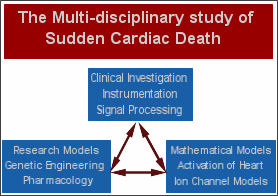Dr Richard Saumarez, a medic and engineer is working with a multidisciplinary team to find a method of predicting the risk of sudden cardiac death, using a combination of mathematical models, research studies and clinical investigations.

One of the aims of his study is to find out which patients at risk of sudden cardiac death are in need of an Implantable Cardioverter Defibrillator (ICD) and which patients are not. Like a pacemaker, ICDs are implanted under the skin. Leads run from the ICD into the heart, and the device monitors the heart to detect any abnormal rhythms. If a dangerous arrhythmia is detected, the ICD delivers an electrical discharge between the lead inside the heart and the casing of the ICD to restore the heart's normal rhythm and prevent sudden cardiac death. The ICD can also act like a pacemaker if the heart is beating too slowly.
ICDs are implanted when tests indicate that a problem with abnormal rhythms may occur. Unfortunately the current tests do not allow reliable predictions of future heart condition. This means that many ICDs are implanted on a precautionary basis, but no heart problems occur and they are never required to deliver a corrective shock. This is a serious issue as an ICD is a very expensive piece of equipment costing approximately £25,000, the procedure to implant the device carries risk, it can trigger unnecessarily causing pain, and patients with ICDs have been found to have a high rate of depression. An improved test would help ensure that only those patients who really need an ICD get an ICD, with clear benefits firstly for the patient and secondly for the health service.
Sudden cardiac death occurs when the heart's abnormal rhythm - ventricular fibrillation - cannot pump an adequate amount of blood to sustain life. Richard's research has shown that the risk of sudden cardiac death can be predicted by measuring how the response to a controlled electrical stimulus spreads through the heart. The heart's response is recorded showing, in the case of patients at risk of sudden death, delayed and fragmentary conduction through the heart in response to a stimulus. This technique is called 'paced electrogram fractionation analysis' (PEFA). In the course of a number of studies, the PEFA technique has been tested in over 680 patients and has been shown to apply to all diseases that have been studied and to be predictive of sudden death, and hence the need for an ICD, in Hypertrophic Cardiomyopathy, which is one of the commonest causes of sudden death in young adults . Animal models of some diseases that cause sudden death, created in Dr Andrew Grace's laboratory (Biochemistry) show a striking similarity to humans when investigated using the PEFA technique. A new generation of equipment is being developed to refine the accuracy of the PEFA results. Professor Bill Dawes is working with Dr Saumarez to construct mathematical models to simulate behaviour of the heart and its response to electric impulses, so that the equipment and analytical methods can be refined to deliver more accurate results. Professor Dawes' role exemplifies the multidisciplinary nature of this work, as his skills and experience of mathematical modelling are founded on his world-leading work on the mathematics of fluid mechanics.
There has been a high regional take up of the PEFA technique established at Papworth Hospital NHS Trust and East Anglian cardiologists now refer patients for assessment. The technique enables patients requiring ICDs to be identified more reliably. In addition, test results giving the all clear can provide invaluable reassurance to patients who had previously held concerns about their family's history of sudden cardiac death. It seems likely that the PEFA technique will be adopted within the NHS.
The design of equipment for commercial exploitation of PEFA has been facilitated by a Medlink Grant that has had Papworth NHS Trust and Cambridge University as partners. The Medlink programme has now been successfully completed and the Department of Health is satisfied with the result, giving it a highly successful rating. The success of the project will accelerate the uptake of the technique and will be used to guide clinical decision making on ICD prescription.
Multiple studies have identified family history as a strong and independent risk factor for sudden cardiac death. Dr Andrew Grace and his team have the largest international collection of DNA samples from patients with a family history of sudden cardiac death, which will be analysed in collaboration with the Wellcome Trust Sanger Institute. This will contribute to a recently established international network to pool databases, sample collections, technologies and expertise to further the understanding of sudden cardiac death.

